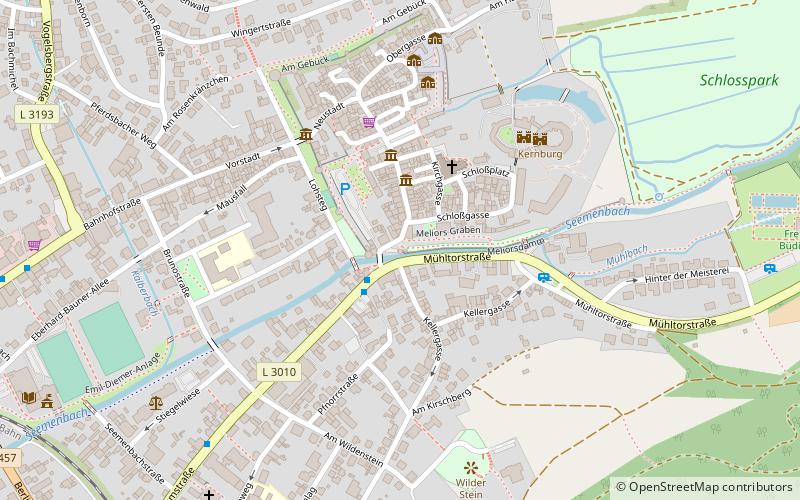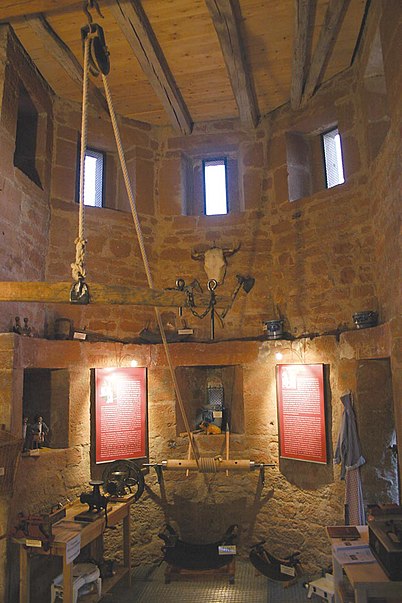Schlaghaus, Büdingen


Facts and practical information
The Schlaghaus in Büdingen is a massive late medieval gatehouse built at the beginning of the 14th century. Originally, the Schlaghaus was located on the most vulnerable southern side of the old town on the far bank of the Seemenbach, counterpart of the high mill gate and connected with a drawbridge. The army and trade road passed by there, which required special protection. In the great "Freiheitsbrief", with which Heinrich II, Lord of Büdingen, gifted his town in 1353, the gate complex with bridge, bars, drawbridge and tollgate is described.
The term blow house is derived from blow. The term has various meanings. It can mean a portcullis or a kind of barrier to protect the bridge system. Schlag also refers to batter walls, which were often built in front of gates in the Middle Ages to divert the attacking enemy away from the direct direction to the gate. Schlag also refers to the place where tolls or tolls had to be paid, the Schlagbaum.
Initially, the Mühlpforte and the Schlaghaus were in a straight line. In the event of enemy attacks, not only the Schlaghaus but also the second gate was at risk from gunfire. With the construction of a mighty wall belt in front of the older city wall between 1480 and 1510 by Count Ludwig II, this weakness was eliminated in 1494 by a redesign of the gate system. The course of the Seemenbach was diverted to the south in front of the "Damm" and the old stream bed was converted into a dry ditch. As an outer gate, the Mühltor near Meliorschen Haus was built further to the west. The S-shaped routing thus prevented the passage of bullets through both gates. This meant that the Schlaghaus also lost its significance as a gate building and was converted into a half-tower of the new fortification. The passage of the gatehouse was walled up and a small tower with a pointed roof was placed in front of the Seemenbach. From the turret it was possible to effectively fire at the stream, the gate bridge and the forecourt. Three of the hump embrasures typical of Büdingen are present on each of two levels. The upper floor served as an escape and guardroom. The military importance is still evidenced by lead bullet bullet holes on the outside during the siege in the fall of 1634. Since 1700, the defensive structure with its walls and towers became less and less important. Thus, the Schlaghaus was used as a "Betzenloch", a prison for minor offenses. Dated carvings inside remind us of this function. It also served as a detention center for the gate guards.
Until 1777, the Metzgerschirn on the Küchenbach served the Büdingen butchers as a slaughterhouse. In that year, the butchers moved their trade to the Schlaghaus, which thus received its further name Schlachthaus. For this purpose, the basement of the tower was filled in and the embrasures there were bricked up. Sandstone slabs with a slight slope were laid on the floor of the slaughter room thus created. This made it possible to channel blood and slaughter waste directly into the Seemenbach stream. The slaughter room was equipped with a slaughter beam and other equipment.
In 1892, district health physician Dr. Hauser criticized the conditions in the Büdingen slaughterhouse. At times, the Seemenbach carried only little water or was dammed up by the millers. As a result, the Seemenbach was often unable to fulfill its function as a sewer. In addition, the entire slaughtering process took place in public, since there was no closable area around the slaughterhouse. The slaughtered livestock was often transported without a cover. Finally, in 1895, the butchers of Büdingen founded the slaughterhouse cooperative. The object of their enterprise was the "construction of a slaughterhouse in Büdingen for joint account". The new slaughterhouse was built quickly and was soon able to take over the function of the slaughterhouse.
For more than 100 years, the loft served as a storage room, most recently for the municipal building yard. As part of the renovation of the old town, the tower was thoroughly renovated in 2005/2006. In the process, the basement of the loft house was uncovered and made visible under a grating. Since September 2006, on the initiative of the slaughterhouse cooperative, the Schlaghaus has housed the Büdingen Butcher Museum. The slaughtering equipment with slaughtering beams and winch were reinstalled for this purpose. Historical butcher's tools and machines are also on display.
Büdingen
Schlaghaus – popular in the area (distance from the attraction)
Nearby attractions include: Witch Tower, Großes Bollwerk, Wilder Stein, Public library.




